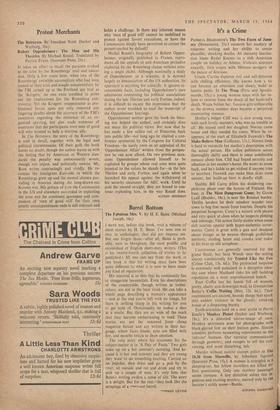It's a Crime
PATRICIA HIGHSMITH'S The Two Faces of Janu- ary (Heinemann, 21s.) reasserts her mastery of suspense writing and her ability to create plausible, shocking deaths. An uncanny fascina- tion binds Rydal Keener to a rich American couple on holiday in Athens. Violence simmers uneasily, then erupts' with Minoan savagery at the palace of Knossos.
Ursula Curtiss explores evil and self-delusion with chilling efficiency. She knows how a tic can become an obsession and slowly build to lunatic panic. In The Wasp (Eyre and Spottis- woode, 15s.) a young woman stays with her in- laws to recover from the shock of her husband's death. Wasps bother her. Tension gets unbearable as the drowsy summer days become a perpetual murmuring menace.
Mother's lodger Cliff was 'a nice young man, with such lovely manners, who was no trouble at all.' He stayed until her daughter Norma came 'home and they needed his room. When he re- appears, at the start of Elizabeth Fenwick's The Make-Believe Man (Gollanzc, 15s.), Norma finds it hard to reconcile her mother's description with the actual person. His sullen politeness seems thoroughly shifty and there is some indefinable menace about him. Cliff .had found security and affection in her mother's home. He wants to come back, and he's liable to get violent if anyone tries to interfere. Fenwick can make blue skies seem sinister; her build-up here is deadly chill.
Shabby Bill Carey pilots his doddering am- phibious plane over the forests of Finland. His base, in The Most Dangerous Game, by Gavin Lyall (Hodder, 18s.), is near the Russian border. Thrifty herders let their reindeer wander into town to beg free meals from tourists. Despite his perpetual hangover, Carey's a wizard with planes and very quick at clues when he suspects plotting and sabotage. The action fairly sizzles when some rich tourists appear with hyper-authentic cover- stories. Carey is great with a gun and deadpan about danger as he weaves through prohibited territory, eluding bears and crooks and radar in his beat-up old aeroplane.
Courtrooms are generally reserved for the grand finale, but Sara Woods uses the setting almost continuously for Trusted Like the Fox (Crime Club, 13s. 6d.). The protracted suspense is extremely well sustained in a deceptive iden- tity case where Maitland risks his still budding reputation on a most unprofessional hunch.
Poor Coffin has his hands full of women, pretty, chatty and downright mad, in Gwendoline Butler's Coffin Waiting (Bles, 12s. 6d.). Their resentments are ancient, broody things that spark into sudden violence in the ghostly, creaking house of a despairing beauty.
Earth-scientists land on a new world in Pierre Boulle's Monkey Planet (Secker and Warburg, 18s.). It's a distorted mirror-image of ours. Monkey sportsmen pose for photographs with black-gloved feet on their human game. Simian scientists perform nauseating experiments on the 'inferior' humans. Our narrator communicates through geometry, and escapes to tell his con- vincing, and most disturbing, tale.
Murder without motive stumps police in The 10.30 from Marseille, by Sebastien Japrisot (Souvenir Press, 15s.). A woman is strangled in a sleeping-car, her fellow travellers are killed be- fore questioning. Only one mystery passenger seems immune. A boy detective solves this in- genious and exciting mystery, marred only by the heroine's sickly name—Bambi.
ANTONIA SANDFORD


































 Previous page
Previous page